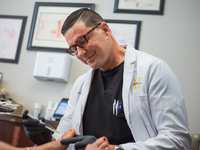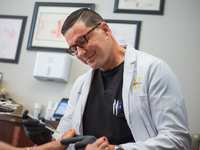- Categories :
- More
The Future of Podiatry Wound Care: Harnessing The Power Of Stem Cells

In the ever-evolving landscape of medical innovation, one breakthrough stands out for its potential to revolutionize podiatry wound care: stem cell therapy. Imagine a treatment that not only accelerates healing but also addresses underlying tissue damage, offering hope to patients with chronic wounds. In this comprehensive article, we’ll delve into the science behind stem cell therapy for podiatry wounds, exploring its mechanisms, benefits, clinical applications, challenges, and implications for the future of foot health.
Stem cells possess the unique ability to differentiate into various cell types and promote tissue repair and regeneration. In podiatry wound care, stem cell therapy harnesses this regenerative capacity to promote healing in chronic wounds that resist conventional treatments. By delivering a concentrated dose of stem cells to the site of injury, clinicians aim to kickstart the body’s natural healing processes, facilitating tissue repair and regeneration.
The nature in which stem cells are harvested reduces the risk of rejection by the body. No foreign cells are used, and the body is given exactly what is needed to begin the healing process. The process may begin faster, and results are more efficient because no toxic chemicals or invasive techniques are used.
MECHANISMS OF ACTION: HOW STEM CELLS FACILITATE WOUND HEALING

To understand the therapeutic mechanisms of stem cell therapy, it’s important to delve into the intricacies of this healing wonder. Stem cells exert their therapeutic effects through multiple mechanisms, including differentiation, paracrine signaling, and immunomodulation.
-
Differentiation: Stem cells can differentiate into specialized cell types, such as skin cells, blood vessels, and connective tissue. They replenish damaged tissue and promote wound closure.
-
Paracrine Signaling: Stem cells secrete a variety of bioactive molecules, known as cytokines and growth factors, that stimulate neighboring cells to proliferate, migrate, and contribute to the healing process.
-
Immunomodulation: Stem cells possess immunomodulatory properties, modulating the inflammatory response and promoting a regenerative microenvironment conducive to healing.

CLINICAL APPLICATIONS: STEM CELL THERAPY IN PODIATRY
In podiatry practice, stem cell therapy holds promise for treating a range of foot, ankle, and leg conditions, including diabetic ulcers, venous stasis ulcers, and non-healing wounds resulting from trauma or surgery. Clinical studies have demonstrated the efficacy of stem cell therapy in promoting wound healing, reducing healing time, and improving patient outcomes.
Moreover, stem cell therapy offers potential advantages over traditional treatments, such as reduced risk of infection, decreased need for amputation, and enhanced quality of life for patients with chronic wounds. While the immediate effects of stem cell therapy may manifest in accelerated wound closure and tissue regeneration, the true measure of success lies in the sustainability of healing over time.
MONITORING PROGRESS AND COLLABORATIVE PATIENT-CENTRIC CARE
Follow-up care serves as a cornerstone of patient management in stem cell therapy for podiatry wounds, offering opportunities to monitor healing progress and provide ongoing support for patients. Regular follow-up appointments enable clinicians to assess wound healing, evaluate treatment responses, and adjust management strategies as needed.
The journey toward sustained healing in stem cell therapy is a collaborative endeavor between patients and healthcare professionals. By fostering open communication, mutual trust, and shared decision-making, clinicians and patients can form a strong alliance to further benefit the healing process.
LOOKING AHEAD: THE FUTURE OF PODIATRY WOUND CARE
The future of podiatry wound care is ripe with possibilities. As research in stem cell biology continues to advance, so does our understanding of the therapeutic potential of stem cells. From exploring novel delivery methods to addressing regulatory challenges, podiatrists are at the forefront of pioneering innovations in wound care.
Stem cell therapy holds the potential to transform the management of chronic wounds, offering hope to patients who previously faced limited treatment options. By leveraging the regenerative power of stem cells, podiatrists can pave the way for improved outcomes, enhanced patient satisfaction, and a brighter future for foot health.

EMBRACING INNOVATION IN PODIATRY PRACTICE
Stem cell therapy represents a groundbreaking approach to podiatry wound care, offering new avenues for healing and regeneration. While challenges remain, the potential benefits of stem cell therapy are too compelling to ignore. By embracing innovation, staying abreast of emerging research, and collaborating with experts in regenerative medicine, podiatrists can position themselves at the forefront of patient care, ushering in a new era of healing for those in need.


















